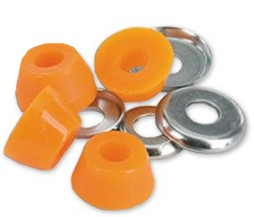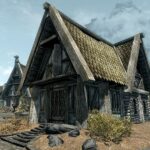Skateboard bushings are crucial components that significantly impact your board’s turning responsiveness and overall riding experience. Understanding the different types of bushings and how they affect your performance is essential for every skater. This comprehensive guide will provide you with the knowledge you need to choose the perfect skateboard bushings for your trucks and skating style.
Understanding Skateboard Bushings
Skateboard truck bushings are the resilient, typically polyurethane rings that encircle the kingpin on your skateboard trucks. These bushings play a vital role in facilitating smooth turning and pivoting. Each truck features two bushings (totalling four for a complete skateboard). The top bushing, positioned above the hanger on the kingpin, contributes to smooth turning. The bottom bushing, located between the hanger and the baseplate, can be adjusted to modify truck responsiveness.
Stiffer bushings offer more resistance, advantageous for performing tricks requiring stability. Softer bushings are ideal for cruising or carving, allowing for easier turning and greater maneuverability. The optimal bushing tightness is a matter of personal preference and can be easily adjusted. Skateboard truck bushings generally come in a universal size, making them compatible with most skateboards, longboards, and cruisers.
 Skateboard Bushings Explained
Skateboard Bushings Explained
Deciphering Skateboard Bushing Durometer
Durometer is the measure of a skateboard bushing’s hardness. It’s typically measured using the Durometer A Scale, ranging from 1 to 100, with higher numbers indicating harder bushings. Some manufacturers use the B Scale, which reads 20 points lower than the A Scale, effectively extending the measurable range for harder bushings. An 80b durometer is equivalent to a 100a durometer.
Softer bushings allow for easier hanger compression, resulting in easier turning. Harder bushings, conversely, provide stiffer turns and increased stability. Experimenting with different durometers for the top and bottom bushings is a common practice among skateboarders.
Skateboard Bushing Shapes and Styles
Beyond durometer, the shape of your skateboard bushings is a crucial factor influencing your ride. Experimentation with different shapes has led to a variety of bushing styles. While some sets feature symmetrical top and bottom bushings, others combine different shapes for specific performance characteristics.
The three fundamental bushing shapes are:
- Conical: Allows for maximum deck lean and easy turning, ideal for carving.
- Barrel: Provides stability and control, suitable for high-speed riding.
- Eliminator: Offers the most resistance and stability, often used in downhill skateboarding.
Here’s a breakdown of common bushing styles:
| Cone/Barrel Bushings: The most versatile option, combining a barrel-shaped bottom bushing for stability and a conical top bushing for increased deck lean and easier carving. Many riders opt for a harder durometer bushing on the bottom for enhanced performance. | |
| Double Barrel Bushings: Featuring two identical barrel-shaped bushings, this style offers superior stability, making it ideal for downhill skating. While not as turn-friendly as conical bushings, using a softer durometer can compensate for this. | |
| Cone Bushings: This style consists of two conical bushings, providing a high degree of deck lean and making them excellent for sharp turns and carving. Also known as “super carve” bushings. | |
| Double Stepped Bushings: Similar to barrel-shaped bushings but with indents on the top and bottom. These bushings provide significant lean resistance and rebound, resulting in very tight trucks, even with softer durometers. Also referred to as step-barrel bushings. | |
| Barrel/Stepped Bushings: Combining a barrel bushing on top with a stepped bushing on the bottom provides excellent stability, making it suitable for downhill longboarding where stability is paramount. This combination also offers substantial rebound. |
Essential Components: Bushing Washers and Bushing Seats
Bushing Washers
Bushing washers are metal washers that are placed around the kingpin on each truck, under the bushings. Their purpose is to prevent bushing deformation from the pressure applied to the trucks. When you purchase skateboard trucks, you’ll get four bushing washers. The washers are usually all the same size, though some brands will include two smaller washers (for the top bushing) and two bigger washers (for the bottom bushing). When assembled, the arrangement from top to bottom around your kingpin should be: bottom washer, bottom bushing, bushing seat, top bushing, top washer, lock nut.
Bushing washers can be flat or slightly cupped. Flat washers enable more lateral slide and flexibility for the bushings. Cupped washers limit bushing movement, preventing deformation or complete blowout. Flat washers offer low resistance, while cupped washers provide higher resistance. The shape of the bushing washer should complement the shape of the bushing you’re using. Avoid pairing cupped washers with extremely soft bushings, as the edge can cut into and damage the bushing.
Bushing Seats
Simply put, a bushing seat is the indented spot around the hanger opening where the bushings will sit. The kingpin fits through the opening, and the bushings are then fitted around the kingpin. The main job of bushing seats is to hold the bushings and stop them from getting too squished from riding pressure.
Bushing seats are generally categorized as either “open” or “restrictive.” Restrictive bushing seats are more confined, with taller walls that securely hold the bushings. Open bushing seats are shallower, compressing the bushing seat less and creating less resistance. It’s important to match your seats with the right kind of bushings, regardless of the bushing seat shape you choose. The desired tightness of your bushing seats depends on your personal preferences and chosen skateboarding style.
Final Thoughts
Choosing the right skateboard bushings involves understanding durometer, shape, and style, as well as considering the role of washers and seats. Experimentation is key to finding the perfect combination that matches your skating style and preferences. A well-chosen set of bushings can dramatically improve your control, stability, and overall riding enjoyment.
